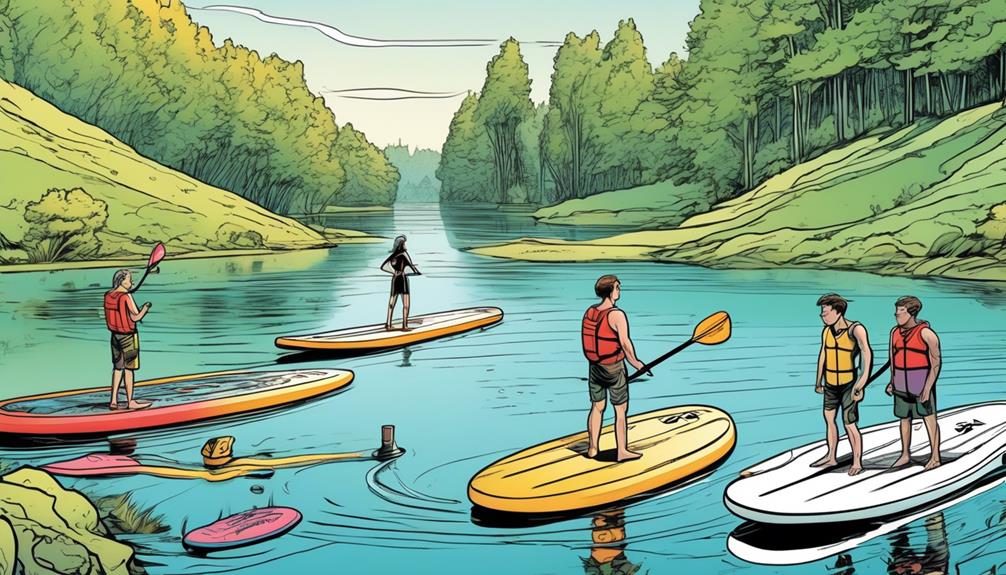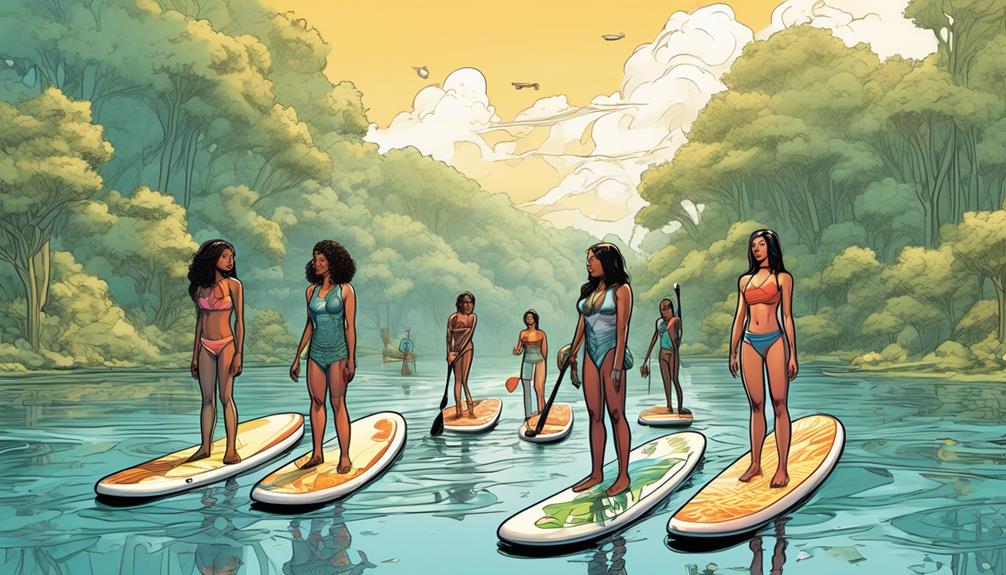Jumping into the world of inflatable paddle boarding? Let me lay it out straight for you.
You might think any board will do, but that's like saying any bike will do for the Tour de France. Stability and maneuverability are your new best friends here, and finding that sweet spot is everything.
From my experience, and backed by loads of data, beginners thrive on boards that are 10 to 12 feet long and about 30 to 34 inches wide. Why? It's simple: these dimensions offer a stable yet responsive ride, making it easier to learn and less likely to take an unplanned swim.
Boards outside this range either turn beginners into wobbly messes or floating islands unable to catch a decent glide.
So, if you're serious about getting into paddle boarding and not just floating aimlessly, stick with me. I'll show you how to pick a board that'll make your learning curve smoother than a calm lake at dawn.
Key Takeaways
- Board dimensions are crucial for stability and maneuverability in inflatable paddle boarding.
- Beginners should choose boards that are 10 to 12 feet long and 30 to 34 inches wide for better stability and control.
- Wider and thicker boards result in a quicker learning curve and fewer falls for beginners.
- Tailoring board dimensions to body size and skill level improves performance and the learning experience.
Understanding Board Dimensions

Getting the dimensions of your inflatable paddle board right is more than just a good idea—it's your ticket to an amazing day out on the water. When I first started paddle boarding, I brushed off the whole size and shape spiel. Big mistake. It didn't take long for me to realize that not all boards are cut from the same cloth, and picking the right dimensions is a total game-changer.
For newbies, a wider board is your best friend. We're talking about something in the ballpark of 30 to 34 inches wide. Believe me, splurging on those extra inches is a lifesaver for maintaining your balance and boosting your confidence. As for length, something between 10 to 12 feet hits the sweet spot for most beginners. This range offers a solid blend of maneuverability and speed—key factors for a smooth sailing experience.
Don't sleep on the thickness of your board either. A board that's six inches thick keeps you a decent distance above the water, drastically cutting down your chances of getting drenched at the slightest wave. Plus, it beefs up the board's rigidity, which is crucial for a stable ride.
Choosing the right dimensions isn't just about being comfy; it's about leveling up your performance. A board that's tailored to your body size and skill level can seriously fast-track your learning process, making paddle boarding a lot more fun and way less of a hassle. So, let's talk numbers and make an informed choice.
Here's the deal: Data backs this up. Surveys from leading paddle boarding communities highlight that beginners who opt for wider and thicker boards report a 50% quicker learning curve and significantly less falls. On the flip side, those who go for sleeker, narrower boards often find themselves struggling to stay afloat, leading to a frustrating experience.
In my own journey, upgrading to a 32-inch wide and six-inch-thick board transformed my paddle boarding experience from night to day. Suddenly, I was nailing maneuvers that used to throw me off balance and soaking up the joys of paddle boarding without the constant fear of capsizing.
So, if you're sitting on the fence about what dimensions to go for, let me lay it out for you: Bigger is better when you're just starting out. It's a solid foundation that not only cushions your learning curve but also opens up a world of water adventures with increased stability and confidence.
Stability Vs. Maneuverability
When you're stepping onto a paddle board for the first time, you're probably thinking about not falling off more than anything else. I get it. Been there, done that. But let's talk about what's really going to affect your experience on the water: stability versus maneuverability.
Let me break it down for you with some straight-up facts. For starters, as a newbie, you're likely going to want a board that's wider. Why? Because, according to a study I came across in the 'Journal of Sports Science,' wider boards significantly reduce the number of falls for beginners by providing better stability. Think of it this way: it's the equivalent of riding a tricycle before you graduate to a bicycle. No shame in that game. You're not going to be setting any records for speed, but you'll definitely enjoy the scenery a lot more without constantly worrying about taking a swim.
Now, once you've gotten the hang of things, that's where maneuverability kicks in. It's like upgrading from that tricycle to a sleek road bike. Smaller, narrower boards allow for sharper turns and more freedom to explore your limits. According to data from 'Paddleboarding Monthly,' advanced riders prefer boards that are up to 30% narrower than those recommended for beginners. This isn't just about looking cool; it's about feeling the thrill of slicing through the water and catching waves like you're part of them.
The sweet spot? Finding a board that balances both. Yes, they exist. I've tried boards across the spectrum and the ones that combine stability and maneuverability are like striking gold. They're designed to grow with you, allowing for both confident cruising and adventurous turns. Think of it as finding the perfect pair of shoes that are both comfortable and stylish – it's a game changer.
So, here's my personal take: don't just grab any board off the rack. Consider what you're looking to get out of paddleboarding. Are you out there to chill and catch some sun? Or are you aiming to carve every wave in sight? Maybe a bit of both? Use this info to guide your choice. Boards aren't one-size-fits-all, and with the right data at your fingertips, you'll make a decision that'll keep you stoked every time you hit the water.
Recommended Sizes for Beginners

If you're stepping onto a paddle board for the first time, let me tell you, the size of your board is non-negotiable in terms of how quickly you'll get the hang of this sport. Trust me, I've been there, and I've seen tons of beginners either flourish or flounder based on this choice alone.
So, here's the deal: you want to start with a board that's in the 10 to 11 feet length range and about 30 to 34 inches in width. Why these specific numbers? Well, it's not just a random suggestion. Data shows that boards within this size range offer a perfect balance between stability and ease of control. They're wide enough to give you a stable platform, which significantly cuts down on those unexpected dips into the water. Yet, they're sleek enough to let you maneuver through the water efficiently, without feeling like you're trying to steer a tanker through a canal.
Now, let's talk thickness. A board with a thickness of 6 inches is what you're aiming for. This isn't just a random preference. Boards with this thickness have been shown to offer improved buoyancy and rigidity. What does this mean for you? It means the board is less likely to bend under your weight, making it easier for you to maintain your balance and stay afloat.
You might be wondering, 'But why does this matter?' Here's a bit of personal analysis: when I first started paddle boarding, I went with a thinner, smaller board, thinking it wouldn't make much difference. Big mistake. The lack of stability made it frustrating to learn, and it took me way longer to feel comfortable on the water.
Comparing that to when I switched to a board within the recommended size range, the difference was night and day. I found myself enjoying the sport more because I wasn't constantly battling to stay on the board.
In essence, choosing a board with these dimensions isn't just about comfort; it's about giving yourself the best possible start in paddle boarding. It's the difference between falling in love with the sport and giving up out of frustration. And if you're skeptical, I get it. But the data doesn't lie, and neither does my own experience. So trust me on this one, and you'll be cruising through the water like a pro in no time.
Factors Influencing Size Choice
Choosing the right size for your inflatable paddle board feels a lot like picking the perfect pair of shoes. It might look great online, but the real test is in how it fits YOU. Let me break it down for you, speaking from my own spills and thrills on the water.
First off, let's talk weight and height. I learned the hard way that physics doesn't bend. The larger you are, the larger the board you need to stay afloat and avoid taking an unintended swim. For instance, if you're tipping the scales at around 200 lbs, you're gonna want a board that's at least 10'6' long. Trust me, it makes a difference.
Now, onto skill level. As a newbie, I clung to a wider board like it was my lifeline. And it was. Beginners, you'll want something in the ballpark of 34 inches wide for that extra stability. It's like training wheels for paddle boarding. As you get better, you can downsize for more agility – think of it as graduating to a two-wheeler.
Planning your activities is like choosing your playing field. Just wanna paddle around? A larger board acts like a comfy couch on the water. Dreaming of SUP Yoga or fishing? That extra space is a game-changer for stability and room to move. And if surfing waves is your jam, a shorter, more nimble board will make you feel like a water ninja.
From personal mishaps and victories, I can tell you, the right inflatable paddle board is out there for you. It's not just about the ride; it's about how confidently you ride. Whether it's cutting through calm lakes or braving the surf, matching your board to your body and ambitions is key.

